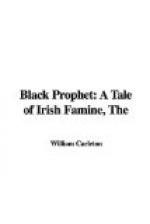* It is as well to state here that the season described in this tale is the dreadful and melancholy one of 1817; and we may add, that in order to avoid the charge of having exaggerated the almost incredible sufferings of the people in that year, we have studiously kept our descriptions of them within the limits of truth. Dr. Cokkigan, in his able and very sensible pamphlet on “Fever and Famine as Cause and Effect in Ireland”—a pamphlet, by the way, which has been the means of conveying most important truths to statesmen, and which ought to be looked on as a great public benefit—has confirmed the accuracy of the gloomy pictures I was forced to draw. Here follow an extract or two:
“It is scarcely necessary to call to recollection the summer of 1810, cold and wet—corn uncut in November, or rotting in the sheaves on the ground—potatoes not ripened (and when unripe there cannot be worse food), containing more water than nutriment—straw at such an extravagant price as to render the obtaining of it for bedding almost impossible, and when procured, retaining from its half-fermented state, so much moisture, that the use was, perhaps, worse than the want of it. The same agent that destroyed the harvest spoiled the turf. Seldom had such a multiplication of evils come together. In some of the former years, although food and bedding were deficient, the portion saved was of good quality, and fuel was not wanting: but in 1815 every comfort that might have compensated for partial want was absent. This description applies to the two years of 1816 and 1817. In midsummer of 1817, the blaze of fever was over the entire country. It had burst forth in almost a thousand different points. Within the short space of a month, in the summer of 1817, the epidemic sprung forth in Tramore, Youghal, Kinsale, Tralee, and Clonmel, in Carrick-on-Suir, Iloscrea, Ballina, Castlebar, Belfast, Armagh, Omagh, Londonderry, Monasterevan, Tullamore and Slane. This simultaneous break-out shows that there must have been some universal cause.”
Again:
“The poor were deprived of employment and were driven from the doors where before they had always received relief, lest they should introduce disease with them. Thus, destitution and fever continued in a vicious circle, each impelling the other, while want of presence of mind aggravated a thousandfold the terrible infliction. Of the miseries that attend a visitation of epidemic fever, few can form a conception. The mere relation of the scenes that occurred in the country, even in one of its last visitations, makes one shudder in reading them. As Barker and Cheyne observe in their report, ’a volume might be filled with instances of the distress occasioned by the visitation of fever in 1817.’”
“’On the road leading from Cork, within a mile of the town (Kanturk), I visited a woman laboring under typhus; on her left lay a child very ill, at the foot of the




